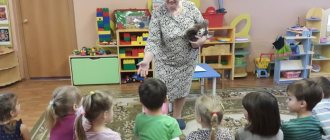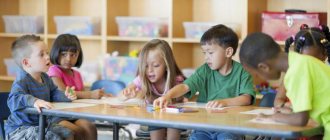teacher Melikova F.M.
DIRECT EDUCATIONAL ACTIVITY educational area “Speech development”
Program content : Check how well children have developed the ability to compose a consistent story about a toy. Exercise children in the ability to form words by analogy.
Tasks:
Educational objectives: To strengthen children’s ability to describe a toy, naming the most characteristic features and various actions with them. Continue to teach how to connect sentences with each other, leading to writing a short story about toys. Practice choosing synonyms and antonyms.
Educational tasks: To cultivate a friendly attitude towards friends, animals, toys. Teach children to put their toys back in their place.
Developmental tasks: Enrich children's vocabulary with the names of surrounding objects (toys, their properties and actions).
Equipment: Toys (pyramid, soft toy hare, doll, car, ball, magic bag)
Progress of the lesson.
| parts | content | methods and techniques |
| Introductory part | Educator: All the children gathered in a circle. I am your friend and you are my friend! Let's hold hands together and smile at each other. (Children sit down, knock on the door) | greetings |
| Main part. | Educator: Oh, guys, do you hear someone knocking on the door. Let's see who's there? (The teacher opens the door, and behind the door is a bag with a letter.) Educator: Guys, here is a letter with riddles that need to be solved. Listen carefully to the riddles and before answering, think. The teacher asks riddles: Teacher: A ball of fluff, a long ear, jumps deftly, loves carrots (hare) He is small in stature, but he is daring, he galloped away from me. Even though it’s always inflated, it’s never boring with it (the ball) Doesn’t fly, doesn’t buzz, the beetle runs down the street, and two brilliant lights are burning in the beetle’s eyes. (car) Blue eyes, golden curls, pink lips. (doll) There are different rings on sticks, they look like a Christmas tree, they amuse the children. (pyramid) Educator: Guys, what is this, how can all this be called in one word. (toys) Educator : Guys, let's play a finger game. A small hare with big ears, a pink nose, and a funny mustache. He digs a deep hole for himself. With strong paws in soft ground. He cleans his fur or sleeps. The bunny always moves his ears. Educator: Let's write a story about toys together. (The teacher takes one of the toys and begins to describe it with the children) Educator : By color, what kind of toys there are, by shape, by size, from what materials (children's answers). Well done boys. Educator: Guys, let's talk about the doll together. (Children's answers) Educator: What is she like, what is she wearing. (Children's answers). Educator: I invite anyone who wants to come up and take any toy (doll, car, pyramid, ball, hare), and the rest help. Educator : And now everyone stood in a circle to play, it’s time. Our game is called “What is What?” The teacher gathers children in a circle. Educator: I will tell you the juice, and you must guess what fruit it is made from. (Orange juice, from orange; apple juice, from apples.) | Surprise moment Guessing riddles Finger game Making up a story game “What from what” |
| Final part | Educator: Guys, you liked our game. What we talked about today. Guys, did you like our new toys? Now you can take the toys and play with them. | Summary of the lesson. |
Lesson duration : 20 minutes.
OOD summary on the topic: “Every toy has its place”
Subject:
“Every toy has its place”
Target:
Strengthen the ability to put toys away.
Tasks:
Educational:
— Strengthen the ability to distribute toys in their places;
— Improve children’s ability to participate in carrying out collective work assignments;
- Learn independently, highlight the disorder in the environment;
Educational:
— Develop a desire for everyday work, careful attitude towards toys;
-Develop accuracy, attention, imagination, creativity;
Educational:
— Foster humane feelings and positive relationships between children;
— Cultivate the desire to work for the common good, to understand the significance of one’s work for others.
Materials:
toys: cars, dolls, dishes, cubes, pyramid; pencils; coloring books; paper; emblems on the baby's chest.
Vocabulary work
: nouns: car, doll, pyramid, cubes, cleaning, help, play area, corner, group room.
Verbs: help, help out, interact, work.
Adjectives: neat, polite, rude, bookish, artistic.
Preliminary work:
reading fiction: K.I. Chukovsky “Moidodyr”, “Fedorino’s Mountain”; memorizing Ouspensky’s poem “Everything is Alright”; conversation about work;
Methods and techniques:
gaming – didactic game; visual - looking at the playroom; practical – children’s independent activities; verbal – teacher’s story, questions.
Progress of direct educational activities.
Conversation about work.
(Children enter the group and sit on chairs)
- Guys, look what happened in the group? (Children's answers).
— Maybe someone in our group played? What changes do you see? Do you put away toys? Why do you need to put away toys? (Children's answers)
- Guys, look, what happened in our group?
- Now let's watch the scene.
Dramatization of Ouspensky's poem "Everything is Alright"
(Guys, show a scene from a poem)
Mom comes home from work, Mom takes off her boots, Mom goes into the house, Mom looks around. — Was there a raid on the apartment? - No. — Did a hippopotamus come to see us? - No. - Maybe the house is not ours? - Our. - Maybe not our floor? - Our. Seryozhka just came and we played a little. - So this is not a collapse? - No. — Didn’t the elephant dance with us? - No. - I am very happy. It turned out that I was worried in vain!
Practical activities. Cleaning toys.
- So who scattered the toys in our absence? (Children's answers)
— Why is it difficult to find a toy? (Children's answers)
- What toys are located in which play corner? What should be in the art corner? (Children's answers)
Summary of GCD for children in the middle group. History of children's toys
Summary of the direct educational activities of children in the middle group
Abstract of children's educational activities in the middle group "History of children's toys"
Description of the material: Dear colleagues! I bring to your attention a summary of direct educational activities for children of the middle group (4-5 years old) on the topic “History of children's toys.” This summary will be useful to teachers of the middle group. This is a summary of an educational lesson aimed at fostering interest in the history of toys and respect for Russian traditions and customs. Integration of educational areas: social-communicative, cognitive, speech, artistic-aesthetic, physical development. Type of activity: visual, motor, cognitive-research, gaming, communicative. Age group: middle Topic: “History of children's toys” Purpose: introducing children to the history of toys Objectives: - development of communication and interaction of the child with adults and peers, formation of positive attitudes towards various types of work and creativity (social and communicative); — development of children’s interests, their curiosity and cognitive motivation; development of imagination and creative activity (cognitive); — enrichment of the active dictionary; development of coherent, grammatically correct dialogical and monologue speech (speech); — implementation of independent creative activity of children; the formation of an aesthetic attitude towards the surrounding world (artistic and aesthetic); - mastering outdoor games with rules; formation of focus and self-regulation in the motor sphere (physical). Preliminary work: 1. Joint visit to the Puppet Theater with parents; 2. Exhibition “Do-it-yourself toys”; 3. Repetition of previously learned poems by A. Borto from the “Toys” series; 4. Examination of plot pictures and composing a story based on them; 5. Watching the cartoon “Living Toy”; 6. Conversation about favorite toys; 7. Learning physical education Means of implementation: photo and video materials with toys from different eras; audio recordings from children's cartoons about toys; individual modeling kits (board, stack, plasticine, napkin); Gena's bi-ba-bo crocodile toy; children's favorite toys. GCD procedure: Children sit on soft cushions on the floor in a semicircle. To the music “Let them run clumsily...” from the cartoon “Cheburashka and the Crocodile Gena,” the teacher brings in the bi-ba-bo toy “Crocodile Gena” with a bag and conducts a dialogue with the children on behalf of the toy. He greets the children and pays attention to how many toys there are in the kindergarten. Addressing the children, he asks them to name and show them their favorite toy, describe it and tell them why he likes it. Listens carefully to the children's answers and invites them to listen to a story about the toys of their childhood. He takes out photographs of toys from those years from his bag, shows them and tells the children about them. He clarifies that previously toys in stores were very expensive and not everyone could afford them, so parents made toys for their children themselves. They were made of wood, straw, cloth, animal bone, feathers, clay, etc. This material is environmentally friendly and does not cause harm to health.
The teacher invites Gene and the children to watch a video using multimedia, which shows the manufacturing process and a story about the first straw toy “Bereginya”. He clarifies that this toy was not only an object of play for the child, but was also his amulet, protecting him from evil spirits.
Next, the teacher suggests comparing modern toys with toys of those years. Find similarities and differences in material, colors, sizes, properties, etc. It should be noted that modern toys have more capabilities: they move, make sounds, react to the approach of a child, etc.
The teacher tells the children and Gena the crocodile that, despite the fact that modern toys are very different from their predecessors, there is one type of toy that has always fascinated children. These are wind-up toys. Gena says that he has just such a toy with him. Shows the children a wind-up monkey. The teacher tells the students that they need to rest a little and, together with the crocodile Gena, conducts a physical lesson “Wind-up toys”: Look, in the store, all the toys on display: (Spread your arms wide to the sides) Wind-up bunnies, Dolls and balls, Fluffy kittens, (Turns to the right -to the left with outstretched arms) Matryoshka dolls, bear cubs - Everyone is sitting on the shelves (Sit down) They want to play with us. (Jumping). Crocodile Gena turns his attention to the clock and says that he has to go, Cheburashka is waiting for him. This is a very good toy and a good friend. He asks the children if they have a Cheburashka toy. Receiving negative answers, Gena invites the children to make their own toy from plasticine. The children happily support Gena’s proposal and say goodbye to him. The teacher shows on the interactive board the stages of sculpting Cheburashka, noting its characteristic features (big ears, triangular nose). After watching, the children begin to work to the musical accompaniment of the cartoon “Crocodile Gena and Cheburashka.” Result of the GCD A follow-up conversation is held: What new did the children learn about toys? What do they particularly remember? At the end of the work, a mini-exhibition with children's works is organized. Group photo for memory. Thank you for your attention!
We recommend watching:
Synopsis of an integrated GCD in kindergarten in the middle group Synopsis of GCD in the middle group on the theme “New Year” Synopsis of a lesson on applications in the middle group of kindergarten. Flowers Summary of GCD for FEMP in the middle group
Similar articles:
Lesson in the middle group “Winter clothes”


